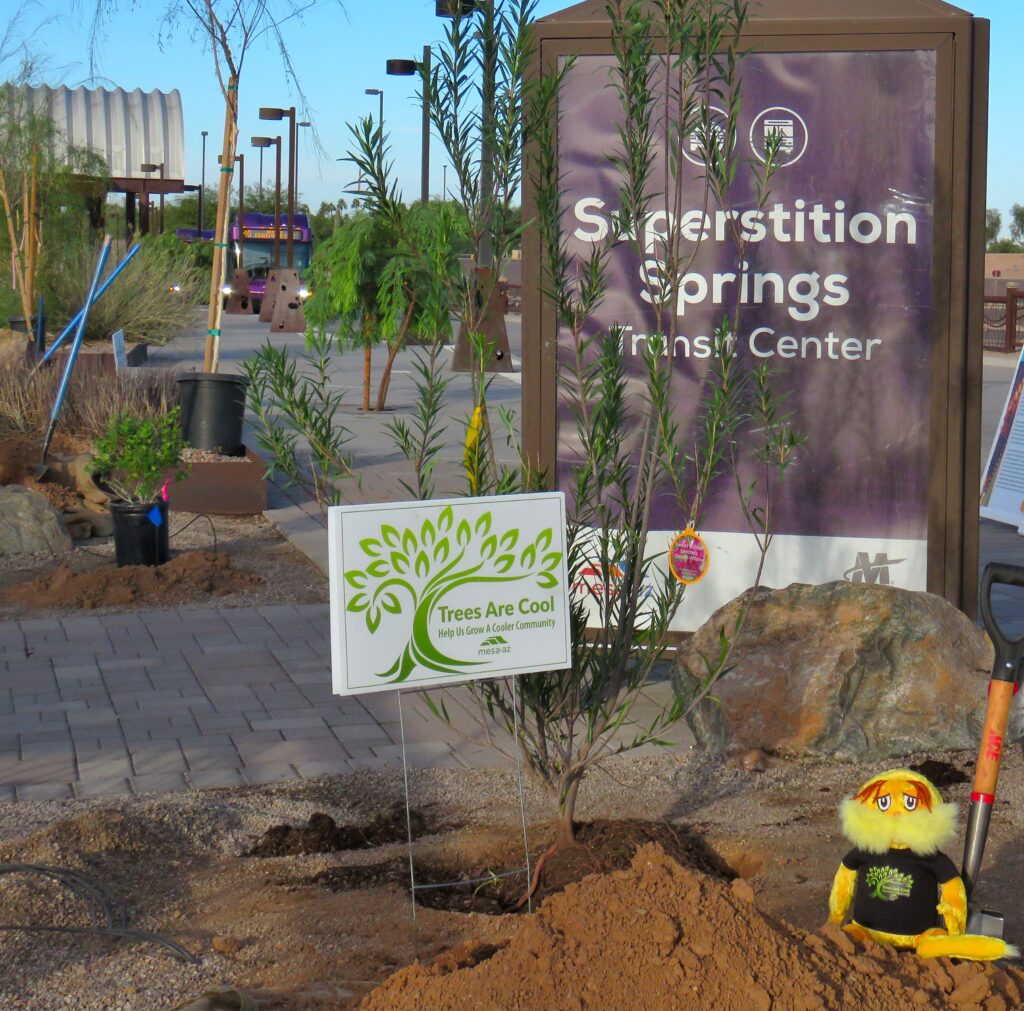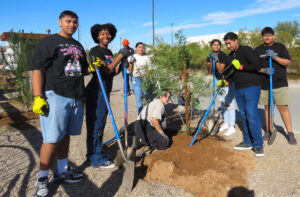
Beautiful trees and shrubs, including milkweed and other pollinator-friendly varieties, now grace the walkways and parking areas of the Superstition Springs Transit Center. This transformative project is the result of collaborative efforts between Mesa and its partners: Meta, Mesa High School, and the Arizona Sustainability Alliance. Additional support for the initiative came from Valley Metro and the Superstition Springs Center (Macerich Property Management staff).
In early 2023, the City of Mesa launched the “Trees Are Cool” initiative with the ambitious goal of planting one million new trees by 2050 (find out more in our blog post, ‘Trees Are Cool – Even During a Drought!‘). One effective strategy to achieve this goal is by forging partnerships with various community members, including nonprofits, schools, and businesses.
This vision became a reality on November 14, 2023, when Mesa hosted a landscape restoration planting event at the Superstition Springs Transit Center. Situated along the bustling U.S. Route 60 at Power Road in Mesa, the transit center serves as a regional hub for commuters and public transportation users. With six bus routes and multiple Valley Metro vanpools, it caters to hundreds of passengers daily.
Superstition Springs Transit Center Background
Completed in 2009, the Superstition Springs Transit Center stands as a flagship transit hub for Mesa and the East Valley. Great care was taken during its construction to ensure harmony with its surroundings and the natural environment while maintaining functionality. The facility comprises two separate components: a park-and-ride with a 297-car capacity, catering to express bus service to Downtown Phoenix and vanpool commuters, and a transit center facilitating local bus routes (two of which connect directly with light rail), offering a vital link for public transportation across the region.
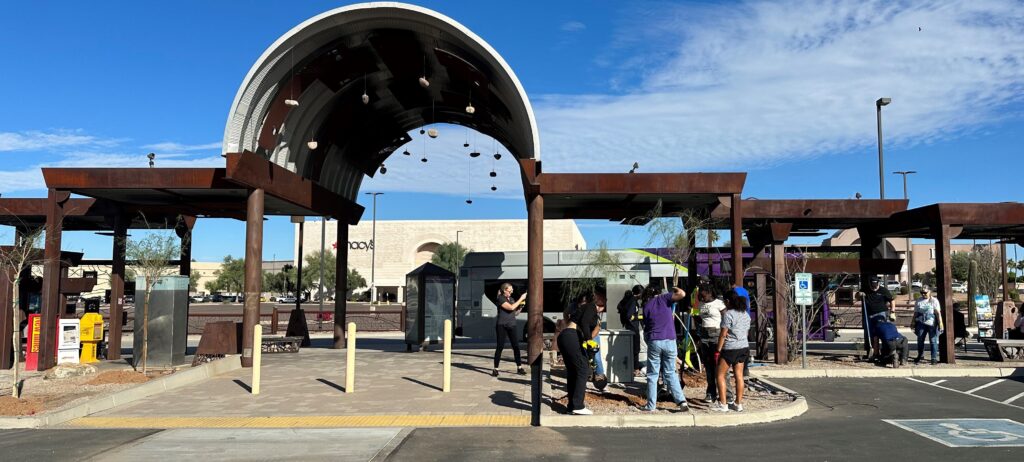
Artistic elements are integrated throughout the transit center, blending the manmade environment with nature. The biophilic design, aimed at fostering connectivity with the natural environment, incorporates native plants, mildly rusting steel, and rocks. Natural meandering patterns seamlessly woven into industrial geometric designs create a space that is both inviting and contemplative. These artistic components were envisioned and brought to life by William Barnhart, a local Mesa artist with a studio in downtown Mesa and art pieces displayed locally and globally.
When initially installed, the transit center featured a diverse array of desert trees and vegetation. Over time, many succumbed to weather, age, or disease. The original design extensively used hybrid palo verde trees, known for their captivating presence in arid landscapes but found to be susceptible to wind damage, particularly in harsh urban environments. The goal of the November 14 event was to replant 108 new trees and 72 new shrubs and groundcovers. All plants lining the pedestrian walkways and parking spaces are Sonoran Desert natives selected for their adaptations to desert heat, cold, and limited rainfall. This renovation promises an immediate, direct, and positive impact on transit riders. The new plantings not only enhance the environment with color but also provide cooling shade, creating a more welcoming atmosphere.
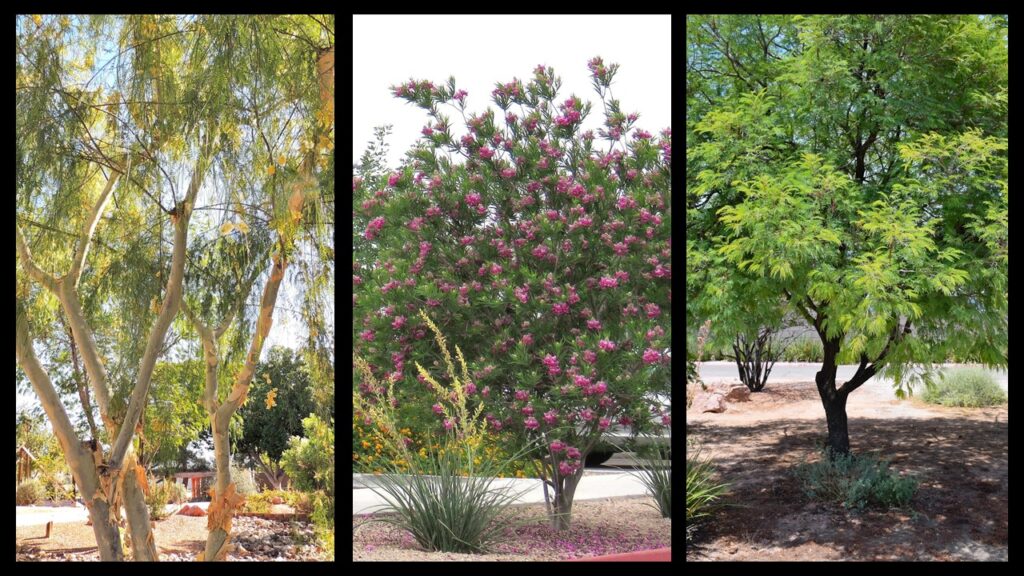
This renovation promises an immediate, direct, and positive impact on transit riders. The new plantings not only enhance the environment with color but also provide cooling shade, creating a more welcoming atmosphere.
Sonoran Desert natives that were selected for the replant include the following trees: Canyon Hackberry, Desert Willow, Ironwood, Lysiloma, Native Mesquite, and Palo Blanco. The following accents, groundcovers, and shrubs were also planted: Agave, Bear Grass, Candelilla, Creosote, Desert Milkweed, Fairy Duster, Fishhook Barrel, Giant Hesperaloe, San Marcos Hibiscus, and Turpentine Bush. A Sonoran Desert wildflower mix was also seeded in select areas.
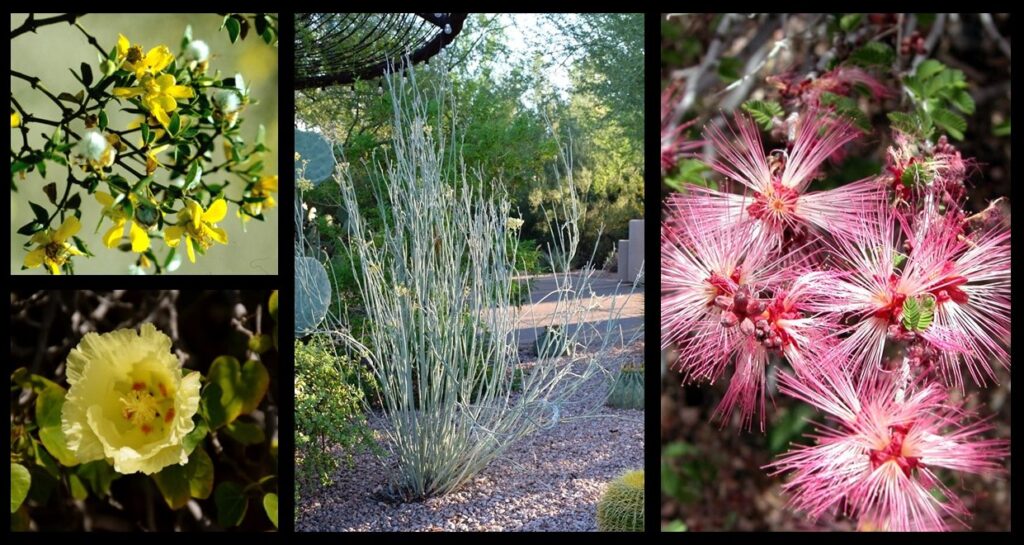
Funding from Meta to Encourage Workforce Development
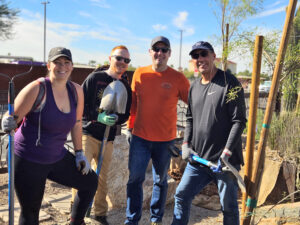
A generous donation from Meta played a crucial role in funding the plantings, supporting both the Trees Are Cool initiative and the National Wildlife Federation’s Mayors’ Monarch Pledge efforts. Meta, currently constructing a state-of-the-art data center in East Mesa, is dedicated to community support through volunteering and partnerships with local schools, nonprofits, and other organizations. David Williams, the community development manager, expressed Meta’s commitment, stating, “Meta is proud to call Mesa home and is dedicated to the long-term vitality of the East Valley. Sustainability initiatives like Trees Are Cool are a great way to bring people together and benefit Mesa residents and wildlife for years to come.”
Many cities are grappling with a significant challenge — the shortage of skilled workers to care for trees, landscaping, and natural areas. Job training and placement in landscape-related fields have not kept pace with demand. Addressing this deficit involves introducing and connecting students to career paths that equip them with the skills needed for meaningful, well-paid work. Successful programs connect young people with mentors, training providers, and employers.
The grant from Meta for the project also facilitated the engagement of the Arizona Sustainability Alliance (AZSA), a nonprofit dedicated to protecting the environment and promoting sustainable living through civic engagement, collaboration, and education. AZSA was ready to enter classrooms to engage with students, and when they looked at schools in close proximity, Mesa High School emerged as an excellent option, situated less than seven miles from the transit center.
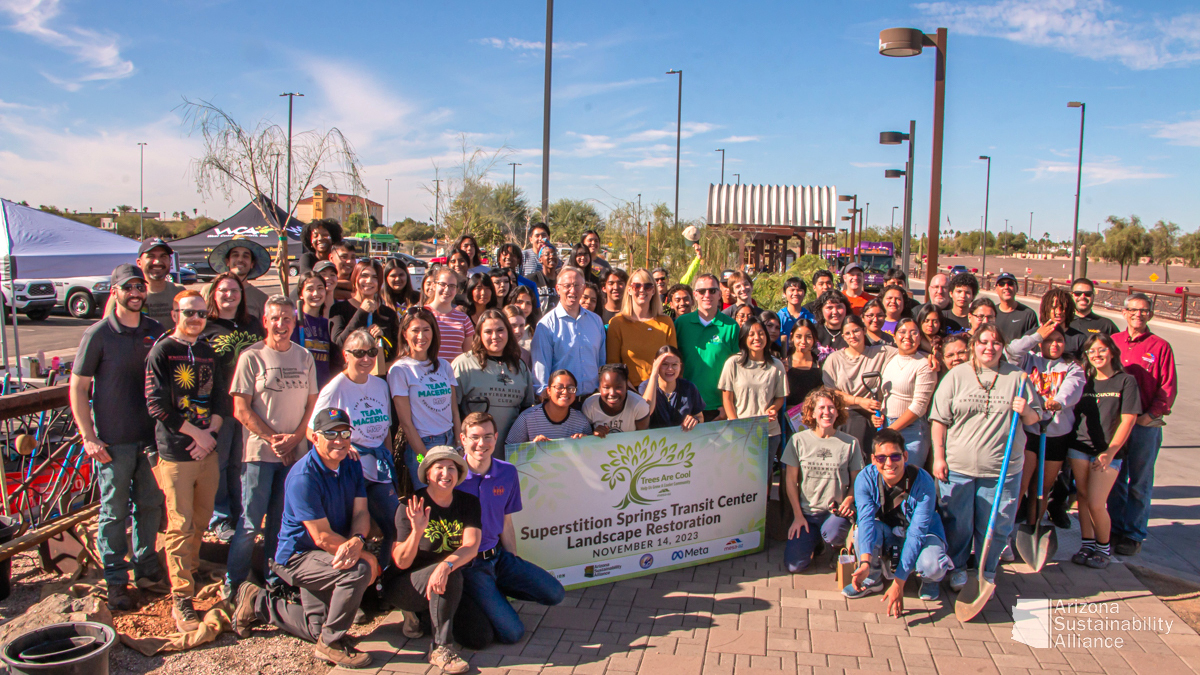
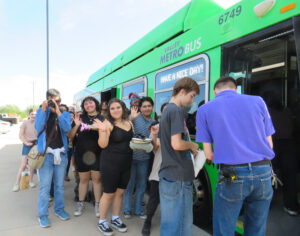
When AZSA connected with Mesa High School, they were fortunate to engage with Jenny Robinson, the Environmental Science Teacher. In addition to teaching environmental science classes, Ms. Robinson plays a key role in leading the school’s environmental club. Both AZSA and City of Mesa staff visited Ms. Robinson’s classroom to introduce students to the advantages of public transit, urban trees, and wildlife habitat restoration through presentations and interactive activities.
The success of this engagement with students can be measured by the impressive number of participants who submitted all required permission slips for the volunteer planting day. An enthusiastic fifty (50) students turned up, eager to contribute to the planting effort. The president and vice president of the school’s environmental club, Magdelena Rameriz and Isa Escorcia, were well-prepared to discuss the project’s significance with Mesa’s Mayor and Councilmembers.
As an additional benefit, the City of Mesa Transit Department organized an opportunity for the students to experience public transit firsthand by taking a Valley Metro bus to the planting event. According to Jenny Robinson, “This opportunity has allowed students to step outside the classroom and understand the impact they can make when working together as a team. Collaborating with others who share the same goals for a healthy future empowers students to take ownership of their own community.”
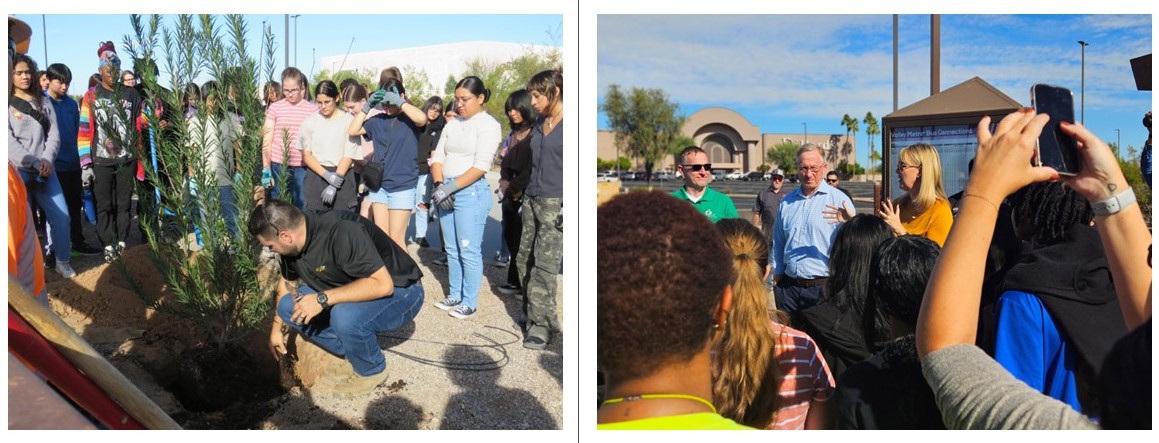
“Events like this, where the public and private sectors come together to plant more trees, are a great example of how we can work together toward a sustainable future for Mesa.” -Mayor John Giles
Project Supports Several Key City of Mesa Sustainability Initiatives
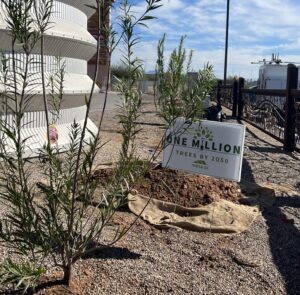
Mesa Mayor John Giles, alongside other city leaders, attended the event to engage with students regarding their classroom learnings and community concerns. Mayor John Giles emphasized, “One of the most effective ways for Mesa to make progress on our Climate Action goals is through community engagement, the fourth pillar of our plan. Events like this, where the public and private sectors unite to plant more trees, serve as an excellent example of how we can collaboratively work towards a sustainable future for Mesa. Involving students from Mesa High School in this project creates a lasting legacy.”
This initiative aligns with several key City of Mesa priorities: enhancing transit opportunities and mobility, supporting the Trees Are Cool initiative, and participating in the Mayors’ Monarch Pledge. Planting trees for shade and to mitigate the impacts of greenhouse gases contributes to the City’s Climate Action Plan, specifically in Heat Mitigation, Air Quality, Energy Efficiency, and Water Stewardship. Furthermore, this project reinforces the City Council’s strategic priorities of a Sustainable Environment and Neighborhoods and Placemaking.
For more information, visit mesaaz.gov/climateaction.
Donna DiFrancesco is a Conservation Coordinator, David Calloway is a Transit Coordinator, and Stacy Bass is a Marketing and Communications Specialist with the City of Mesa, AZ, one of 19 Water – Use It Wisely partners to offer water-saving advice and programs. Photos not specifically credited above by Donna DiFrancesco.


